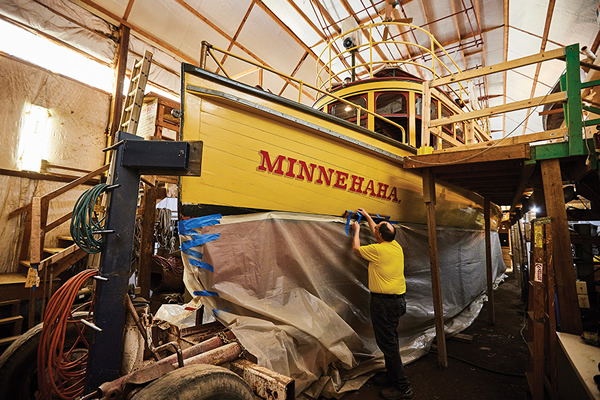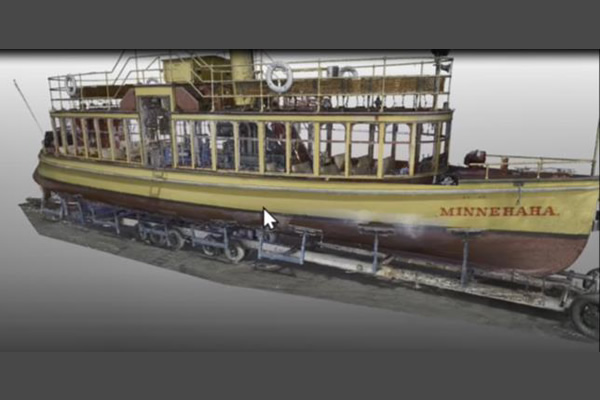“Efforts are underway to resume the services of the Minnehaha on Lake Minnetonka.”
Featured in Lk Mtka Magazine

1906 Steamboat

“Efforts are underway to resume the services of the Minnehaha on Lake Minnetonka.”

Upcoming Virtual Demonstrations of New 3D Scanning of Minnehaha… Newsletter
By Fred Fey
An Engineer’s day aboard the steamboat Minnehaha begins about an hour before the rest of the crew even shows up. After checking the condition of the engine, boiler, and bilges, he reads the log book for any problems from the last run. Then he starts following a checklist. The first thing on the list is to position various valves necessary for operation and to start the diesel generator which supplies electricity. He then checks fuel and water levels and makes notations on the log sheet. After making sure the boiler water is at the right level, he switches the boiler to the low fire position to warm the system up. The boiler is a Cleaver-Brooks oil-fired package boiler that provides the engine with 180 pounds of steam. While the boiler is coming up to operating pressure, he will add makeup water to storage tanks and begin oiling the engine.
When the boiler pressure reaches about 90 PSI, a boiler water sample is analyzed and, if necessary, chemicals are added to protect against corrosion and deposits which could affect heat transfer. When pressure reaches about 150 PSI, it is time to begin warming the engine. The boiler’s steam isolation valves are opened and steam is allowed to flow into the engine. The engine is in neutral at this point and steam condenses as it warms the cold engine. The engine’s cylinder drains are then opened to allow the condensate to drain to the condenser. The engine is a “triple-expansion condensing steam engine,” which means the steam expands as it travels from a high pressure piston to an intermediate piston, and then to a low pressure piston. Each piston is larger than the one before it. The exhaust steam is then directed from the third cylinder to a condenser. The condenser contains tubes which are cooled by lake water to condense the spent steam, which is then pumped back to the boiler to be reheated to 180 PSI.
By John Palmer
Modern recreational boats like the many you see on Lake Minnetonka are usually made of fiberglass or some other long-lasting plastic that requires very little maintenance to stay looking fresh. Modern engines and hardware are made of non-corroding, long-wearing materials and can go for years without much worry. But now take a look at some of those beautiful old “wood boats” that you also often see out on the lake, sedately cruising by. To stay looking pristine, they need a lot of work, often requiring a complete new finish every few years and extensive care to prevent corrosion and wear. Minnehaha is one in that class – in spades! She looks fresh and new every summer when you take your annual ride, but it takes a long Minnesota winter of work to keep her in that condition. Few except those hardy souls who spend Saturdays repairing, adjusting, sanding and painting can appreciate the work it takes to keep her “ship shape.”
So what really happened between October 9 when Minnehaha was towed from Niccum’s Landing to the “Barn” and May 7, when she made the return journey to begin her 2011 sailing season? Well, so much was done in those seven months that it isn’t even possible to describe it all. However, a few of the most important items included a complete inspection and overhaul of the boiler and all its associated parts (a task which is done every two years). Also in this year’s investment was a complete re-coating of the refractory lining, replacement of many gaskets, studs and bolts, plus replacement of the burner nozzles and a full tune up. The engine itself, although it ran well all summer, was completely torn down and carefully inspected. Bearings were adjusted, packings were replaced, and everything was adjusted for smooth operation.